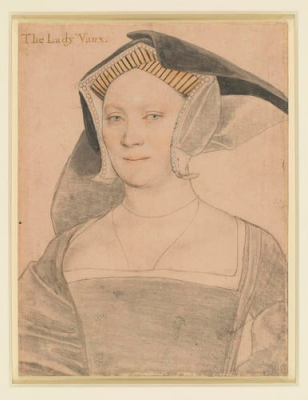Stunning Holbein exhibition at King's Gallery

Lady Elizabeth Vaux by Hans Holbein. (c) HM King Charles III
'Holbein at the Tudor Court' is the latest exhibition at the former Queen's Gallery, Buckingham Palace, renamed as the King's Gallery on 4 December, focusing particularly on magnificent drawings of personalities at Henry VIII's court. Religious paintings, portraits, miniatures, designs for metalwork and book illustrations by the enigmatic master of the Northern Renaissance and those influenced by him, are included in this splendid display of works from the Royal Collection.
Hans Holbein was born in Augsburg around 1547/8. His German father, brother and uncle were all painters. Son of a noted religious panel painter, Hans Holbein the Younger also achieved fame painting many significant religious panels and altar pieces before leaving for Basel around 1519. Due to the prevailing Reforming religious climate causing a lack of religious commissions he sought new patronages elsewhere, leading him to eventually becoming court painter in England.
He painted Erasmus who gave him a letter of introduction to fellow humanist and statesman Sir Thomas More. Holbein spent a year living with More's household in London. His painting of the family was lost in a fire but preparatory drawings - unique portraits in themselves are a wonderful memorial.
Entering the Gallery, the celebrated 'Noli me Tangere' faces the onlooker. Painted on oak panel in English style, it is Holbein's first work in England. It is not known whom the commission was for or where it originally hung. On closer examination the crosses in the background would seem to have a separate cross bar, as in contemporary understanding, and would indicate Holbein had incredible perception.
Works by artists influenced by Holbein are also displayed. A painting of the Madonna and Child is believed to have been a favourite devotional picture of the young Henry VIII.
At the far end of the room is a cabinet with printed books illustrated with Holbein's intricate woodcuts, including More's 'Utopia' and Erasmus' Greek New Testament.
Holbein's portrait drawings uniquely capture his sitters' characteristics and soul. They appear contemporary and realistic. A fascinating range of courtiers and their wives are presented to us, each expressing their personalities through Holbein's great skill. Most of these drawing are preparatory for oil portraits. However, they offer rare insights to the characters at Henry's court, from the visionary Sir Thomas More and his family, to the arrogant ruthlessness of Sir Richard Southwell and the cunning, callous Thomas Cromwell, architect of the Dissolution of the Monasteries. It is said the eyes are the mirror of the soul and certainly Holbein portrays his sitter's innermost self through their eyes and other facial definitions. Two drawings of More portray him as Chancellor of Lancaster and later Lord Chancellor. The former shows him more relaxed than in the latter where he appears more care worn. More declared Holbein "a wonderful artist".
A delightful, rare drawing portrays Princess Mary Tudor, later Queen. Despite its poor condition, the picture depicts the youthful princess sympathetically as a fragile beauty. Probably drawn after 1537 when she returned to court and King Henry's favour, she has a wary look in her eyes.
Wealthy Baron Thomas Vaux and his wife attended her coronation. He wrote poetry, including 'A Contented Mynde' celebrating the "quiet minde…clear from worldly care". His portrait drawing is of a kindly, distinguished man.
Vaux's captivating wife, Elizabeth Cheney, gazes sidelong with a hint of apprehension and a gentle smile on her lips. The chalk drawing depicts chains about her neck, but we do not see the pendant. However, her finished portrait survives at Hampton Court Palace and shows a stunning jewel of the Madonna and Child, maybe designed by Holbein himself as he designed many beautiful jewels for the court. She is also holding a pink carnation, symbolic of marriage, but also an emblem of Our Lady. The Vaux's Catholicism meant exiling themselves from court after 1535 to live quietly in their Northamptonshire country estate to avoid compromising their faith. Both died of plague in 1556.
Holbein's' own beliefs remain elusive, and he had commissions from both Catholics and Reformers. However, examining clues, rather as in Shakespeare, that are hidden in his art and the lack of information about his personal life and even his burial place in England could indicate he remained a closet Catholic.
One of Holbein's favourite motifs is the vine, symbolic of the Eucharist.
Portraits and drawings of the powerful Norfolk family, senior Roman Catholic peers, who held the highest offices of England, falling in and out of favour, reveal a ruthless streak.
An etched suit of armour belonging to Henry VIII illustrates Holbein's metalwork skills.
An excellent book by senior curator, Kate Heard, accompanies the exhibition, although I question the referencing of Catholics as 'traditionalists' and Protestants as 'liberals'. There was a liberal Catholic element who sought reform within Catholicism which is overlooked.
Don't miss the room exhibiting Holbein's techniques and use of pigments in a small room on the right on exiting the main exhibition. It provides fascinating insights into his artistic and technical mastery.
Lunchtime talks and other activities offer further insights to Holbeins' portrayal of the Tudor court in this sensational exhibition.
See: www.rct.uk/visit/the-queens-gallery-buckingham-palace
Holbein at the Tudor Court' runs until 14 April 2024
Thursday- Monday,10-5.30pm - Admission £9.50-£19


















